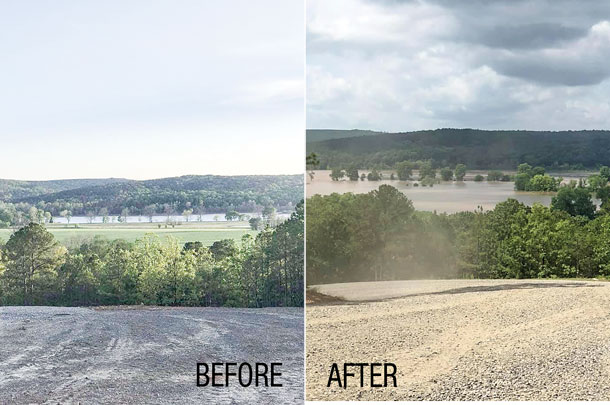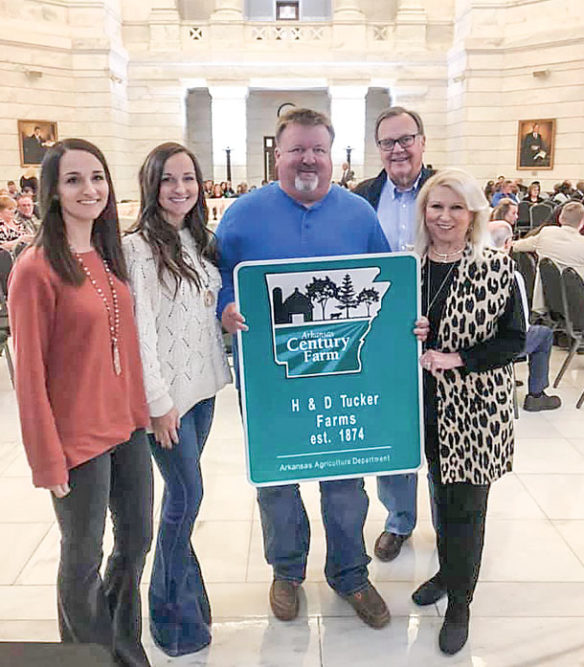Water surged through H&D Tucker Farms where fields of crops once stood. Although the farm includes a mile of the Arkansas River, one might have thought it was much more by looking over the farm’s fields in June 2019.
H&D Tucker Farms began in 1874 and is a cow and calf farm near Mayflower, Arkansas. In 2000, they expanded to include crops. Jill Edwards, 26, spearheads the family operation with two full-time employees and a wide variety of family members that help when needed. Her grandparents, John Ray Evans and Dian Evans, and her father, John Hartley Evans, own the farm.
Edwards says she felt sickened when she looked out over the crop fields. “There is no way to describe it.”
 A before and after comparison of a field of bermudagrass and the impact of the flood. Photo by Jill Edwards.
A before and after comparison of a field of bermudagrass and the impact of the flood. Photo by Jill Edwards.One year after the dreadful floods in the Midwest, H&D Tucker Farms still is recovering from the damage done to their crop fields.
The farm is divided into two properties. The cattle are about 15 miles away from the crops, Edwards says. The crop fields are closer to the river and received the worst of the flooding.
“There were places it [the water] was 20 feet deep,” Edwards says. “You couldn’t see any center pivots or … anything.”
Thirty days after the river flooded, the water began to recede off the crop fields.
Unfortunately, the flooding of the crop fields was not the worst of Edwards’ worries for H&D Tucker Farm, she says. The impact of the flood on the soil consistency and quality would take months of recovery.
“The river brought in sand and silty loam over the top of our fields,” she says. “Trying to work the ground when the river went down and the ground dried out [was difficult]. It was like quicksand.”
When anyone tried to drive a tractor across the new, unfavorable ground, it sank in the dirt, Edwards says. She termed this overhaul of sand and silty loam as “soot.”
“The way it was deposited on the field was not farmable,” Edwards says.
Yet some of the soot would benefit the family. This surprising benefit did not come without its challenges. The family used machinery to mix the deposited soil with the original soil in the fields.
“A lot of the [soot] material had to be completely removed, but in some places, we incorporated it,” Edwards says.
For example, on fields with a majority of sandy soil that received silty-loam soil from the flood, the new material was mixed in to improve the quality.
“We ended up bringing in dozers, backhoes and off-road dump trucks,” Edwards says. “We started digging up all the material and hauling it to the edge of the river. We put it on the edge of the riverbank trying to get our fields ready.”
Edwards’ family also owns a construction company, so they were lucky to have the necessary equipment to repair their fields and recreate drainage ditches once the water receded, Edwards says.
Even now, a year after the first heavy rains began, the H&D Tucker Farms crew still is releveling and disking hay fields.
Chris Schaeffer is part owner of Schaeffer Brothers’ Farms, which neighbors H&D Tucker Farms. He says he has deep concerns for the ability of his soil to hold up against future excess rain.
“We don’t have any of our levies fixed to protect us,” Schaeffer says.
Holes, some as large as half an acre and 20 feet deep, were found on Schaeffer’s farm after the water drained.
The water “ate” away at the field and pulled soil with it.
“It just kept on ‘eating’ and spread it [the soil] in a perfect line right down through the middle of the field,” Schaeffer says.
The Schaeffer family’s decision to cut their hay crop in the days leading up to the Arkansas River overflowing proved as a blessing, since it saved them from having to buy hay for their cattle this winter.
“It was just a struggle on some of our meadows and cow pastures,” he says. “When we took the cows back down there, they didn’t have much pasture.”
Damaged cattle pastures were an obstacle for their farm, Schaeffer says. They are still feeding hay to cattle in some of their pastures because the grass was delayed, Schaeffer says. Part of the herd was moved to H&D Tucker Farms’ ranch.
The recovery process has been ongoing for Schaeffer and his family, he says. After a year, they were approximately 65% done.
“We just haven’t had enough dry weather in a long time to get anything done,” Schaeffer says.
Schaeffer’s goals are to level off cow pastures, fence fields, fill in remaining holes and remove debris and sand left in their pastures so grass can grow.
“I feel like it’s going to [cost] 125,000 to 130,000 dollars when it’s all said and done,” Schaeffer says in regard to filling in the holes on their fields.
They hired a contractor to help them complete the work.
Schaeffer Brothers Farms and H&D Tucker Farms were among those who lost hay, crops and bermuda forage to flooded fields.
“It was a tough year for forage,” says Derrell Peel, agricultural economics professor at Oklahoma State University. “Hay production struggled last year.”
The hay quality last year showed the impact of the excess moisture and water.
Along the Mississippi River, fields were buried under 2 to 3 feet of silt, which ruined some crop fields.
“Some of that farmland will probably never be recovered,” Peel says.
While the road to recovery has been difficult, H&D Tucker Farms has shown how some preparation is possible for these types of disasters. The family knew when the signs were pointing toward an approaching flood, having gone through a flood twice before, Edwards says.
“All spring, the river was high,” Edwards says. “We kept telling ourselves, ‘We are set up for a flood.’”
They look at hydrographs and local predictions to monitor the water level of the Arkansas River.
“At our area, 270 [feet] is where it becomes a moderate flood,” Edwards says, “and 280 [feet] is a major flood.”
A few days of heavy rain in eastern Oklahoma gave them a week to prepare. Semi trucks were departing their property with the last of their salvageable hay bales one night, and the next morning it was flooded.
“This year, it [the flood] got so high the river current was flowing through our farm,” Edwards says. Access was impossible with any vehicle, except maybe a boat.
Edwards and her employees rushed out to pull the plugs on power units and remove the motors on their center pivots when they expected a flood. Any equipment susceptible to water damage had to be relocated to high ground.
“You can’t prepare for it, but you can’t farm each year scared the river is going to flood,” Edwards says.
Although their farm experienced setbacks, Edwards says she recognizes the potential risk that comes with great reward from farming in the river valley where the land is suitable for row crops.
“My advice would be to not get discouraged,” Edwards says. “Farming is a gamble. I think most farmers are tough anyway.”











